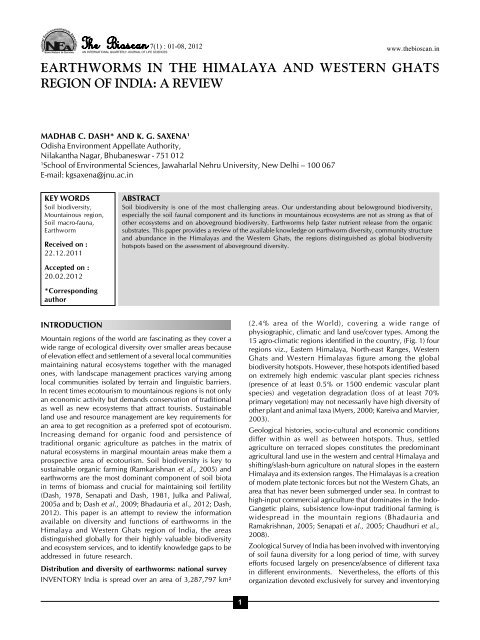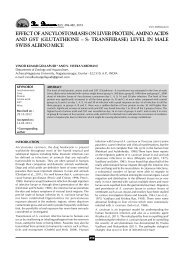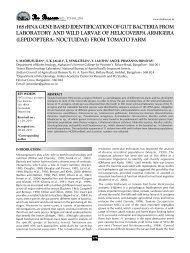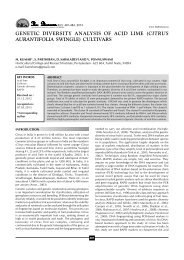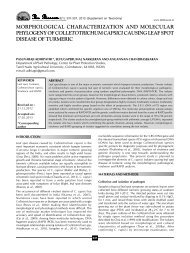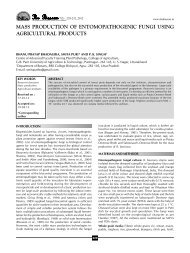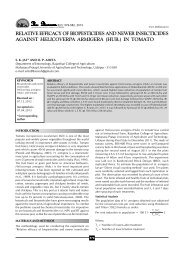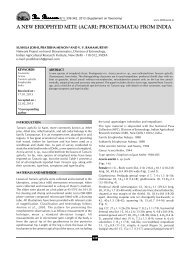earthworms in the himalaya and western ghats ... - THE BIOSCAN
earthworms in the himalaya and western ghats ... - THE BIOSCAN
earthworms in the himalaya and western ghats ... - THE BIOSCAN
You also want an ePaper? Increase the reach of your titles
YUMPU automatically turns print PDFs into web optimized ePapers that Google loves.
NSave Nature to Survive<br />
7(1) : 01-08, 2012<br />
1<br />
www.<strong>the</strong>bioscan.<strong>in</strong><br />
EARTHWORMS IN <strong>THE</strong> HIMALAYA AND WESTERN GHATS<br />
REGION OF INDIA: A REVIEW<br />
MADHAB C. DASH* AND K. G. SAXENA1 Odisha Environment Appellate Authority,<br />
Nilakantha Nagar, Bhubaneswar - 751 012<br />
1School of Environmental Sciences, Jawaharlal Nehru University, New Delhi – 100 067<br />
E-mail: kgsaxena@jnu.ac.<strong>in</strong><br />
KEY WORDS<br />
Soil biodiversity,<br />
Mounta<strong>in</strong>ous region,<br />
Soil macro-fauna,<br />
Earthworm<br />
Received on :<br />
22.12.2011<br />
Accepted on :<br />
20.02.2012<br />
*Correspond<strong>in</strong>g<br />
author<br />
INTRODUCTION<br />
ABSTRACT<br />
Soil biodiversity is one of <strong>the</strong> most challeng<strong>in</strong>g areas. Our underst<strong>and</strong><strong>in</strong>g about belowground biodiversity,<br />
especially <strong>the</strong> soil faunal component <strong>and</strong> its functions <strong>in</strong> mounta<strong>in</strong>ous ecosystems are not as strong as that of<br />
o<strong>the</strong>r ecosystems <strong>and</strong> on aboveground biodiversity. Earthworms help faster nutrient release from <strong>the</strong> organic<br />
substrates. This paper provides a review of <strong>the</strong> available knowledge on earthworm diversity, community structure<br />
<strong>and</strong> abundance <strong>in</strong> <strong>the</strong> Himalayas <strong>and</strong> <strong>the</strong> Western Ghats, <strong>the</strong> regions dist<strong>in</strong>guished as global biodiversity<br />
hotspots based on <strong>the</strong> assessment of aboveground diversity.<br />
Mounta<strong>in</strong> regions of <strong>the</strong> world are fasc<strong>in</strong>at<strong>in</strong>g as <strong>the</strong>y cover a<br />
wide range of ecological diversity over smaller areas because<br />
of elevation effect <strong>and</strong> settlement of a several local communities<br />
ma<strong>in</strong>ta<strong>in</strong><strong>in</strong>g natural ecosystems toge<strong>the</strong>r with <strong>the</strong> managed<br />
ones, with l<strong>and</strong>scape management practices vary<strong>in</strong>g among<br />
local communities isolated by terra<strong>in</strong> <strong>and</strong> l<strong>in</strong>guistic barriers.<br />
In recent times ecotourism to mounta<strong>in</strong>ous regions is not only<br />
an economic activity but dem<strong>and</strong>s conservation of traditional<br />
as well as new ecosystems that attract tourists. Susta<strong>in</strong>able<br />
l<strong>and</strong> use <strong>and</strong> resource management are key requirements for<br />
an area to get recognition as a preferred spot of ecotourism.<br />
Increas<strong>in</strong>g dem<strong>and</strong> for organic food <strong>and</strong> persistence of<br />
traditional organic agriculture as patches <strong>in</strong> <strong>the</strong> matrix of<br />
natural ecosystems <strong>in</strong> marg<strong>in</strong>al mounta<strong>in</strong> areas make <strong>the</strong>m a<br />
prospective area of ecotourism. Soil biodiversity is key to<br />
susta<strong>in</strong>able organic farm<strong>in</strong>g (Ramkarishnan et al., 2005) <strong>and</strong><br />
<strong>earthworms</strong> are <strong>the</strong> most dom<strong>in</strong>ant component of soil biota<br />
<strong>in</strong> terms of biomass <strong>and</strong> crucial for ma<strong>in</strong>ta<strong>in</strong><strong>in</strong>g soil fertility<br />
(Dash, 1978, Senapati <strong>and</strong> Dash, 1981, Julka <strong>and</strong> Paliwal,<br />
2005a <strong>and</strong> b; Dash et al., 2009; Bhadauria et al., 2012; Dash,<br />
2012). This paper is an attempt to review <strong>the</strong> <strong>in</strong>formation<br />
available on diversity <strong>and</strong> functions of <strong>earthworms</strong> <strong>in</strong> <strong>the</strong><br />
Himalaya <strong>and</strong> Western Ghats region of India, <strong>the</strong> areas<br />
dist<strong>in</strong>guished globally for <strong>the</strong>ir highly valuable biodiversity<br />
<strong>and</strong> ecosystem services, <strong>and</strong> to identify knowledge gaps to be<br />
addressed <strong>in</strong> future research.<br />
Distribution <strong>and</strong> diversity of <strong>earthworms</strong>: national survey<br />
INVENTORY India is spread over an area of 3,287,797 km²<br />
(2.4% area of <strong>the</strong> World), cover<strong>in</strong>g a wide range of<br />
physiographic, climatic <strong>and</strong> l<strong>and</strong> use/cover types. Among <strong>the</strong><br />
15 agro-climatic regions identified <strong>in</strong> <strong>the</strong> country, (Fig. 1) four<br />
regions viz., Eastern Himalaya, North-east Ranges, Western<br />
Ghats <strong>and</strong> Western Himalayas figure among <strong>the</strong> global<br />
biodiversity hotspots. However, <strong>the</strong>se hotspots identified based<br />
on extremely high endemic vascular plant species richness<br />
(presence of at least 0.5% or 1500 endemic vascular plant<br />
species) <strong>and</strong> vegetation degradation (loss of at least 70%<br />
primary vegetation) may not necessarily have high diversity of<br />
o<strong>the</strong>r plant <strong>and</strong> animal taxa (Myers, 2000; Kareiva <strong>and</strong> Marvier,<br />
2003).<br />
Geological histories, socio-cultural <strong>and</strong> economic conditions<br />
differ with<strong>in</strong> as well as between hotspots. Thus, settled<br />
agriculture on terraced slopes constitutes <strong>the</strong> predom<strong>in</strong>ant<br />
agricultural l<strong>and</strong> use <strong>in</strong> <strong>the</strong> <strong>western</strong> <strong>and</strong> central Himalaya <strong>and</strong><br />
shift<strong>in</strong>g/slash-burn agriculture on natural slopes <strong>in</strong> <strong>the</strong> eastern<br />
Himalaya <strong>and</strong> its extension ranges. The Himalayas is a creation<br />
of modern plate tectonic forces but not <strong>the</strong> Western Ghats, an<br />
area that has never been submerged under sea. In contrast to<br />
high-<strong>in</strong>put commercial agriculture that dom<strong>in</strong>ates <strong>in</strong> <strong>the</strong> Indo-<br />
Gangetic pla<strong>in</strong>s, subsistence low-<strong>in</strong>put traditional farm<strong>in</strong>g is<br />
widespread <strong>in</strong> <strong>the</strong> mounta<strong>in</strong> regions (Bhadauria <strong>and</strong><br />
Ramakrishnan, 2005; Senapati et al., 2005; Chaudhuri et al.,<br />
2008).<br />
Zoological Survey of India has been <strong>in</strong>volved with <strong>in</strong>ventory<strong>in</strong>g<br />
of soil fauna diversity for a long period of time, with survey<br />
efforts focused largely on presence/absence of different taxa<br />
<strong>in</strong> different environments. Never<strong>the</strong>less, <strong>the</strong> efforts of this<br />
organization devoted exclusively for survey <strong>and</strong> <strong>in</strong>ventory<strong>in</strong>g
MADHAB C. DASH AND K. G. SAXENA<br />
of <strong>the</strong> faunal wealth of <strong>the</strong> country are augmented by many<br />
researchers <strong>in</strong> o<strong>the</strong>r research <strong>and</strong> development <strong>in</strong>stitutions.<br />
N<strong>in</strong>e families of <strong>earthworms</strong> with 69 genera <strong>and</strong> 418 species<br />
have been reported from India. On <strong>the</strong> basis of available data,<br />
<strong>the</strong> Western Ghats <strong>and</strong> West Coastal Pla<strong>in</strong>s would st<strong>and</strong> out<br />
as <strong>the</strong> regions with <strong>the</strong> highest level of earthworm species<br />
richness followed by Eastern Himalayan Region, Sou<strong>the</strong>rn<br />
Plateau, Western Himalayan Region, Eastern Coastal Pla<strong>in</strong>s<br />
<strong>and</strong> Eastern Ghats, Gangetic Pla<strong>in</strong>s, Gujarat pla<strong>in</strong>s, Isl<strong>and</strong>s,<br />
Western dry Regions <strong>and</strong> transgangetc regions (Julka <strong>and</strong><br />
Mukherjee, 1984; Julka <strong>and</strong> Paliwal, 2005a <strong>and</strong> b; Dash <strong>and</strong><br />
Dash, 2008). The Western Ghats region is home to 53%<br />
species known from India compared to 26% <strong>and</strong> 12% <strong>in</strong> <strong>the</strong><br />
case of <strong>the</strong> Eastern Himalaya <strong>and</strong> <strong>the</strong> Western Himalaya,<br />
respectively. Drawida (38 species) is <strong>the</strong> most species rich<br />
genus followed by Megascolex (30 species) <strong>in</strong> <strong>the</strong> Western<br />
Ghats, Perionyx (33 species) followed by Drawida (14 species)<br />
<strong>in</strong> <strong>the</strong> Eastern Himalaya, <strong>and</strong> Perionyx <strong>and</strong> Amynthas (4<br />
species <strong>in</strong> each Genus) <strong>in</strong> <strong>the</strong> Western Himalaya. The Western<br />
Ghats harbour 193 native species compared to 85 <strong>in</strong> <strong>the</strong> Eastern<br />
Himalaya <strong>and</strong> 22 <strong>in</strong> <strong>the</strong> Western Himalaya, though <strong>the</strong> three<br />
regions do not differ much <strong>in</strong> terms of number exotic species<br />
(25-26). Among <strong>the</strong> native peregr<strong>in</strong>e species associated with<br />
agroecosystems, Octochaetona palniensis is conf<strong>in</strong>ed to <strong>the</strong><br />
Western Ghats <strong>and</strong> Lennogaster pusillus <strong>and</strong> Eutyphoeus spp.<br />
to <strong>the</strong> Western Himalaya. Among <strong>the</strong> exotics associated with<br />
agroecosystems, Drawida japonica was able to establish only<br />
<strong>in</strong> <strong>the</strong> Western Himalaya, while Dichogaster aff<strong>in</strong>is <strong>and</strong><br />
Pontoscolex corethrurus could establish <strong>in</strong> Eastern Himalaya<br />
<strong>and</strong> WesternGhats region but not <strong>in</strong> <strong>the</strong> Western Himalaya<br />
(Table 1).<br />
Earthworm communities <strong>and</strong> populations<br />
Studies <strong>in</strong> village l<strong>and</strong>scapes <strong>in</strong> central/<strong>western</strong> Himalaya<br />
(Bhadauria et al., 2000, S<strong>in</strong>ha et al., 2003) showed occurrence<br />
of three species <strong>in</strong> pasture soils compared to eight species <strong>in</strong><br />
o<strong>the</strong>r l<strong>and</strong>-uses, with Exotic Amynthas corticis be<strong>in</strong>g <strong>the</strong> most<br />
common species. Biological <strong>in</strong>vasion was observed <strong>in</strong> both<br />
early <strong>and</strong> late successional stages.<br />
Bhadauria <strong>and</strong> Ramakrishnan (2005) found three native<br />
species, viz., Tonoscolex horai, Drawida assamensis <strong>and</strong><br />
Perionyx sp. <strong>in</strong> <strong>the</strong> primary forest <strong>in</strong> north-east India.<br />
Conversion of primary forest for slashes <strong>and</strong> burn agriculture<br />
resulted <strong>in</strong> <strong>the</strong> loss of two native species <strong>and</strong> colonization of<br />
<strong>the</strong> disturbed area by ano<strong>the</strong>r native species viz., Nelloscolex<br />
strigosus <strong>and</strong> exotic Amynthas corticis. Although richness of<br />
native species <strong>in</strong>creased <strong>and</strong> <strong>the</strong> native species were able to<br />
coexist with <strong>the</strong> exotic species dur<strong>in</strong>g secondary succession<br />
after ab<strong>and</strong>onment of cultivation, complete restoration of native<br />
earthworm species assemblage did not occur. A similar trend<br />
was observed <strong>in</strong> central/<strong>western</strong> Himalayan region, though<br />
<strong>the</strong>re were differences <strong>in</strong> species found <strong>in</strong> <strong>the</strong> <strong>western</strong> <strong>and</strong><br />
eastern Himalaya (Bhadauria et al., 2012).<br />
Chaudhuri et al. (2008) found that conversion of primary<br />
forests to rubber plantations <strong>in</strong> Tripura led to dom<strong>in</strong>ance of<br />
<strong>the</strong> exotic-endogeic Pontoscolex corethrurus as well as a<br />
change <strong>in</strong> <strong>the</strong> functional status of this species, from endogeic<br />
<strong>in</strong> <strong>the</strong> primary forests to endo-anecic <strong>and</strong> endo-epigeic <strong>in</strong><br />
plantations. In general <strong>the</strong> change <strong>in</strong> l<strong>and</strong> use pattern or loss<br />
2<br />
of primary forest followed establishment of some exotic species<br />
<strong>and</strong> also replacement of some natives by o<strong>the</strong>r native species.<br />
Epigeic <strong>and</strong> anecic species, such as Dichogaster bolaui,<br />
Drawida willsi, Perionyx excavatus, Perionyx sansibaricus,<br />
Ramiella sp. <strong>and</strong> Lampito mauritii are widely distributed <strong>and</strong><br />
valued for <strong>the</strong>ir use <strong>in</strong> vermitechnology <strong>in</strong> Western <strong>and</strong> Eastern<br />
Table 1: Native peregr<strong>in</strong>e <strong>and</strong> exotic earthworm species associated<br />
with agroecosystems <strong>in</strong> <strong>the</strong> Himalaya <strong>and</strong> <strong>the</strong> Western Ghats region<br />
of India (based on Julka <strong>and</strong> Paliwal, 2005a &b <strong>and</strong> personal<br />
communication with Julka; A, absent; P, present)<br />
Native peregr<strong>in</strong>e Western Eastern Western<br />
species Himalaya Himalaya Ghats<br />
Lampito mauritii A P P<br />
Perionyx excavatus P P P<br />
Perionyx sansibaricus P A P<br />
Octochaetona beatrix<br />
Octochaetona surensis<br />
P A P<br />
Octochaetona palniensis A A P<br />
Lennogaster pusillus P A A<br />
Ramiella bishambari P A P<br />
Eytyphoeus <strong>in</strong>commodus P A A<br />
Eutyphoeus michaelseni P A A<br />
Eytophoeus waltoni P A A<br />
Drawida willsi A A A<br />
Drawida calebi A A A<br />
Drawida nepalensis P P A<br />
Thatonia gracilis<br />
Exotic species<br />
P A A<br />
Dichogaster aff<strong>in</strong>is A P P<br />
Dichogaster bolaui P P P<br />
Amynthas alex<strong>and</strong>ri P P P<br />
Amynthas corticis P P P<br />
Amynthas morrisi P P P<br />
Metaphire houlleti P P P<br />
Metaphire posthuma P P P<br />
Polypheiritima eleongata A P P<br />
Drawida japonica P A A<br />
Pontoscolex corethrurus A P P<br />
Ocnerodrilus occidentalis P A P<br />
Allobophora parva P P P<br />
Aporrectodea cal. trapezoiedes P P P<br />
Aporrectodearosea rosearosea P P P<br />
Eisenia fetida P P P<br />
Octolasion tyrtaeum<br />
Endemic genus/species<br />
P P P<br />
Curgiona A A P<br />
Kotegeharia A A P<br />
Mallehulla A A P<br />
Priodochaeta A A P<br />
Karmiella A A P<br />
Troyia A A P<br />
Comarodrilus A A P<br />
Chaetocotoides A A P<br />
Parryodrilus A A P<br />
Dashiella A A P<br />
Moniligaster A A P<br />
Celeriella A A P<br />
Lampito A A P<br />
Travoscolides A A P<br />
Wahoscolex A A P<br />
Tonoscolex A P A<br />
Kanchuria A P A<br />
Perionyx (4 species) P A A<br />
Eutyphoeus (2 species) P A A<br />
Plutellus (1 species) P A A
Table 2: Density <strong>and</strong> biomass of <strong>earthworms</strong> (m -2 ) <strong>in</strong> different areas <strong>in</strong> <strong>the</strong> Indian mounta<strong>in</strong>ous region (blank fields <strong>in</strong>dicate non-availability of data)<br />
L<strong>and</strong> use/ ecosystems Diversity Density (number of <strong>in</strong>dividuals m-2 ) Average/ range of biomass Trends References<br />
(wet weight, g)<br />
P<strong>in</strong>e woodl<strong>and</strong>, 9-52 4.4-9.4 Reddy <strong>and</strong> Alfred, Shill<strong>in</strong>g,<br />
Meghalaya (1978)<br />
Mixed woodl<strong>and</strong>, 30-118 Julka <strong>and</strong> Mukherjee Solan,<br />
H. P. (1984)<br />
Humid Tropical 5 Species: Amynthas alex<strong>and</strong>ri, 315(28-281 <strong>in</strong> different micro sites Two peaks, one dur<strong>in</strong>g & Reddy (1987)<br />
deciduous forest, A. P. A. diffr<strong>in</strong>gens, Metaphire posthuma, with<strong>in</strong> forest ecosystem) <strong>the</strong> o<strong>the</strong>r at <strong>the</strong> end of <strong>the</strong><br />
(Eastern Ghats) M. houlleti, Dichogaster sp. ra<strong>in</strong>y season<br />
Shift<strong>in</strong>g agriculture at 3 species:Megascolides antrophytes, 68 Peak density immediately Mishra <strong>and</strong><br />
Nangpoh <strong>in</strong> North- Drawida assamensis, Nelloscolex strigosus after ra<strong>in</strong>y season Ramakrishnan, 1988<br />
Eastern India<br />
Shift<strong>in</strong>g agriculture at 5 Species:Amynthas diffr<strong>in</strong>gens, Drawida 4-47 <strong>in</strong> cropp<strong>in</strong>g phase, 50 <strong>in</strong> fallow - Peak density dur<strong>in</strong>g ra<strong>in</strong>y Bhadauria <strong>and</strong><br />
Shillong <strong>in</strong> north- assamensis, Eutyphoeus festivus, Nelloscolex phase season except Amynthas Ramakrishnan, 1989<br />
eastern India strigosus, Tonoscolex horaii diffr<strong>in</strong>gens , which peaked<br />
<strong>in</strong> w<strong>in</strong>ter<br />
Pasture Kumaon 3 species:Amynthasdiffr<strong>in</strong>gens, Amynthas 139 25 Peak density at <strong>the</strong> end of Kaushal <strong>and</strong><br />
Himalaya alex<strong>and</strong>ri, Eisenia fetida ra<strong>in</strong>y season Bisht, 1994<br />
Cultivated soil One speciesAmynthas alex<strong>and</strong>ri 58 Peak density dur<strong>in</strong>g Kaushal et al. (1995)<br />
Kumaon Himalaya ra<strong>in</strong>y season<br />
A village l<strong>and</strong>scape <strong>in</strong> 8 species: Amynthas alex<strong>and</strong>ri, Bimastos Traditional agro forestry system: 147; Traditional agro forestry All species except B. Bhadauria et al.<br />
Garhwal Himalaya parvus, Metaphire anomala, Metaphire Traditional pure crop system: 132; system: 266; Traditional parvus showed a strong (2012)<br />
birmanica, Drawida nepalensis, Perionyx Moderately degraded natural forest: pure crop system: 199; effect of season on .<br />
excavatus, Lennogaster pusilla, 63; Rehabilitated Agricultural l<strong>and</strong> : 63; Moderately degraded natural population size, with <strong>the</strong><br />
Octochaetona beatrix Ab<strong>and</strong>oned agricultural l<strong>and</strong>: 27; forest: 51; Rehabilitated highest abundance <strong>and</strong><br />
Rehabilitated forest l<strong>and</strong>: 8; Agricultural l<strong>and</strong> : 21; biomass values observed<br />
Highly degraded forest l<strong>and</strong>: 5 Ab<strong>and</strong>oned agricultural dur<strong>in</strong>g ra<strong>in</strong>y season. Only<br />
l<strong>and</strong>: 16; Rehabilitated forest D. nepalensis <strong>and</strong> M.<br />
l<strong>and</strong>: 24; Highly degraded birmanica were a little<br />
forest l<strong>and</strong>: 11 bit abundant dur<strong>in</strong>g dry<br />
season <strong>in</strong> traditional agro<br />
forestry system<br />
Village l<strong>and</strong>scape <strong>in</strong> 8 Species:Bimastus parvus, Octolasion Climax forest: 526,Mixed forest: 309, Peak density dur<strong>in</strong>g Bhadauria <strong>and</strong><br />
Kumaon Himalaya tyrtaeum, Octochaetona beatrix, Amynthas 5-year-old p<strong>in</strong>e: 287, 40-year-old p<strong>in</strong>e: ra<strong>in</strong>y season Ramakrishnan, 2000<br />
corticis, Eutyophoeus festivus, E. nanianus, 940, grassl<strong>and</strong> :353<br />
E. waltonii, Drawida sp.<br />
Village l<strong>and</strong>scape <strong>in</strong> 7 Species:Amynthas corticis, Drawida 108-247 <strong>in</strong> forests, 89-235 <strong>in</strong> Abundance <strong>in</strong> p<strong>in</strong>e forest- S<strong>in</strong>ha et al. (2003)<br />
Garhwal Himalaya nepalensis, Allobophora parva, Eutyphoeus agro-ecosystems higher but diversity lower<br />
pharp<strong>in</strong>gianus, Octochaetona beatrix, compared to oak forest<br />
Perionyx sp., Lennogaster pusillus<br />
N<strong>and</strong>adevi Biosphere 8 species: Lennogaster pusillus, Metaphire Lower elevation: Home garden- 100, 9- 100 Peak density at <strong>the</strong> end of Maikhuri et al., 2008<br />
Reserve <strong>in</strong> Garhwal houlleti, M. anomala, Ocnerodrilus p<strong>in</strong>e forest:5-10, oak forest: 5, Irrigated ra<strong>in</strong>y season<br />
Himalaya occidentalis, Dendrodrilus rubidus, agriculture-5, Ra<strong>in</strong>fed agriculture: 5-25<br />
Aporrectodea callig<strong>in</strong>osa, Amynthas corticis, Higher elevationHome garden:10-150,<br />
Drawida nepalensis Alp<strong>in</strong>e pasture:5-25, Alp<strong>in</strong>e forest: 10-15<br />
Rubber plantations <strong>in</strong> 20 species:Glossoscolecidae- Pontoscolex 10-262(mean ~109)Pontoscolex 9-100 (mean 43.4 ) Chaudhuri et al.<br />
Tripura <strong>in</strong> <strong>the</strong> north- corethrurus, Octochaetidae- Eytyphoeus corethrurus-dom<strong>in</strong>ant72% of total Pontoscolex corethrurus- (2008)<br />
eastern Himalaya gigas,E.gammiei,E. comillahnus, density, Kanchuria spp-1-12%, 61.5%Of total biomass<br />
E assamaensis,E. festivas,Eutyphoeus spp., Metaphire houlleti-3.6%<br />
Dichogaster bolaui, D.aff<strong>in</strong>is, Lenogaster<br />
chittagongnensis, Octochaetona beatrix,<br />
Megascolecidae-Metaphire houlleti,<br />
Perionyx spp.,Kanchuria sumerianus,<br />
Kanchuria sp 1 & sp.2, Moniligastridae<br />
- Drawida nepalensis, Drawida sp-1,<br />
Drawida sp-2,Gordiodrilus elegans<br />
3<br />
EARTHWORMS IN <strong>THE</strong> HIMALAYA AND WESTERN GHATS
MADHAB C. DASH AND K. G. SAXENA<br />
Table 2: Density <strong>and</strong> biomass of <strong>earthworms</strong> (m -2 ) <strong>in</strong> different areas <strong>in</strong> <strong>the</strong> Indian mounta<strong>in</strong>ous region (blank fields <strong>in</strong>dicate non-availability of data)<br />
L<strong>and</strong> use/ ecosystems Diversity Density (number of <strong>in</strong>dividuals m-2 ) Average/ range of biomass Trends References<br />
(wet weight, g)<br />
Nilagiri, Biosphere Fourteen species:Dichogaster aff<strong>in</strong>is, Natural forests: 159;Forest plantations: Ch<strong>and</strong>rashekara et<br />
Reserve: , Kerala area Drawida modesta, D.barwelli impertusa, 350; Palms: 258Cropl<strong>and</strong>s: 640; al. (2008)<br />
<strong>in</strong> <strong>the</strong> Western Ghats D.ghatensis, D. gr<strong>and</strong>is, Glyphidrilus Fallows: 124<br />
ann<strong>and</strong>alei, Haplochetalla sp., Lampito<br />
mauritii, Megascolex <strong>in</strong>signis, M. triangularis,<br />
Octochaetona beatrix, Parryodrilus lavellei,<br />
Plutellus variabilis, Pontoscolex corethrurus<br />
Nilgiri Biosphere 13 species: Drawida somavarapatna, Natural forests: 477Forest plantations:<br />
reserve: Karnataka area Drawida modesta,Drawida fakir, Drawida 303Cardamom plantations: 443<br />
<strong>in</strong> <strong>the</strong> Western Ghats pellucida,Lampito mauritii,Metaphire Cropl<strong>and</strong>s: 595Fallows: 343<br />
holoutii,Megascolex curgensis,Megascolex<br />
felisiceta,Amynthas corticis,Octochaetoides<br />
castellanes,Pontoscolex corethrurus,<br />
Dendrodrilus rubidus,Cargia narayani<br />
A segment of Western 14-825 Earthworms ma<strong>in</strong>ly Rossi <strong>and</strong> Blanchart<br />
exhibited temporal (2005)<br />
Ghats variability while some o<strong>the</strong>r<br />
soil organisms were<br />
affected more by<br />
management practices<br />
4<br />
Table 3: Ecological category, feed<strong>in</strong>g habit, <strong>and</strong> habitat <strong>and</strong> size relationship of eight species of <strong>earthworms</strong> of rubber plantation <strong>in</strong> Tripura (Chaudhuri et al., 2008; Chaudhuri <strong>and</strong><br />
Bhattacharjee, 2009)<br />
Species Family Size(mm) L, length; Color Feed<strong>in</strong>g habit Distributi on Ecological Soiltemp (°c) Soilmoisture Soil Soil organic<br />
B, breadth pattern category (pH:4.4-5.2) (g %)v pH matter(g %)<br />
Pontoscolex Glossoscolecidae L=72-100B=4-5 Lightly Geophagous Exotic Topsoil 19-32 10-29 4.5-4.8 1.7-2.4<br />
corethrurus pigmented peregr<strong>in</strong>e endogeic<br />
DrawidaPapillifer Moniligastridae L=45-90B=3-4 Deeply Phytogeophagous Endemic Epianecic 22-32 10-29 4.5-4.7 1.6-2.4<br />
papillifer pigmented<br />
Drawi Moniligastridae L=60-80B=4-5 Lightly Phytogeophagous Endemic Topsoil 21-31 10-29 4.4-5.2 1.5-2.0<br />
daassamensis pigmented endogeic<br />
Metaphire Megascolecidae L=100-160B=3-6 Deeply Phytogeophagous Endemic Epianecic 21-28 14-20 4.4-5.2 1.6-2.0<br />
houlleti pigmented dorsally peregr<strong>in</strong>e<br />
Eutyphoeus Octochaetidae L=70-135B=2-4 Lightly Geophagous Endemic Mesohumic 21-27 17-18 4.5-4.6 1.7-2.0<br />
comillahnus pigmented endogeic<br />
Dichogaster Octochaetidae L=35-42B=1-2 Moderately Phytophagous Exotic Epigeic 21-28 17-21 4.8-5.2 1.8-2.0<br />
aff<strong>in</strong>is pigmented peregr<strong>in</strong>e<br />
Octochaetona Octochaetidae L=60-120B=4-5 Lightly Geophagous Endemic Subsoil 24-28 11..5-14 4.7-4.8 1.6-2.0<br />
beatrix pigmented peregr<strong>in</strong>e endogeic<br />
Lennogaster Octochaetidae L=40-50B=1.5-2.5 Lightly Phytogeophagous Endemic Topsoil 24-30 16-18 4.7-4.8 1.5-2.0<br />
chittagongensis pigmented peregr<strong>in</strong>e endogeic
Ghats (Dash <strong>and</strong> Senapati, 1985; Dash <strong>and</strong> Dash, 2008; Dash<br />
et al., 2009). Haplochetalla spp is widespread <strong>in</strong> laterite <strong>and</strong><br />
red soils of <strong>the</strong> Western Ghats.<br />
Studies <strong>in</strong> different l<strong>and</strong>-uses <strong>in</strong> <strong>the</strong> state of Karnataka <strong>in</strong> south<br />
India showed species composition of earthworm communities<br />
<strong>in</strong> natural forests closer to that <strong>in</strong> plantations (coffee, Acacia<br />
<strong>and</strong> cardamom plantations) <strong>and</strong> paddy fields but radically<br />
different from that <strong>in</strong> grassl<strong>and</strong>s. Pontoscolex corethrurus, an<br />
endogeic exotic species, was found <strong>in</strong> all l<strong>and</strong>-uses (Kale et<br />
al., 2008, Ch<strong>and</strong>rashekara et al., 2008). Studies carried out <strong>in</strong><br />
Eastern Ghat region also showed variation <strong>in</strong> species<br />
composition between l<strong>and</strong> uses but a species like Lampito<br />
mauritii persisted <strong>in</strong> all l<strong>and</strong> uses (Dash <strong>and</strong> Patra, 1977;<br />
Senapati <strong>and</strong> Dash, 1981; Mishra <strong>and</strong> Dash, 1984; Senapati<br />
et al., 2005).<br />
Population <strong>and</strong> biomass<br />
Data available on earthworm population diversity, density,<br />
biomass <strong>in</strong> different mounta<strong>in</strong>ous regions of India are<br />
summarized <strong>in</strong> Table 2. Earthworm density <strong>and</strong> biomass are<br />
<strong>in</strong>fluenced by a whole range of abiotic <strong>and</strong> biotic factors. A<br />
high level of environmental heterogeneity <strong>and</strong> variation <strong>in</strong><br />
l<strong>and</strong> use/management practices <strong>in</strong> mounta<strong>in</strong>s may result <strong>in</strong><br />
huge variation <strong>in</strong> biodiversity with<strong>in</strong> an Agroclimatic region.<br />
Metaphire anomala, Metaphire houlleti, Ocnerodrilus<br />
occidentalis, Dendrodrilus rubidus <strong>and</strong> Aporrectordea<br />
callig<strong>in</strong>osa occurred <strong>in</strong> <strong>the</strong> N<strong>and</strong>a Devi Biosphere Reserve, a<br />
relatively cool area with lower degree of anthropogenic<br />
pressures due to legal protection but not <strong>in</strong> Hariyali l<strong>and</strong>scape,<br />
a comparatively warmer area faced to more <strong>in</strong>tense human<br />
disturbances <strong>in</strong> <strong>the</strong> absence of any legal protection.<br />
Allobophora parva, Eutyophoeus pharap<strong>in</strong>gianus,<br />
Octochaetona beatrix <strong>and</strong> Perionyx spp. occurred <strong>in</strong> <strong>the</strong> latter<br />
Arabian Sea<br />
Pakistan<br />
Indian Ocean<br />
Nepal<br />
Physiographic zones<br />
central highl<strong>and</strong>s<br />
east coast<br />
east deccan<br />
eastern <strong>ghats</strong><br />
eastern <strong>himalaya</strong>s<br />
eastern pla<strong>in</strong>s<br />
north deccan<br />
north east ranges<br />
nor<strong>the</strong>rn pla<strong>in</strong>s<br />
south deccan<br />
west coast<br />
<strong>western</strong> <strong>ghats</strong><br />
<strong>western</strong> <strong>himalaya</strong>s<br />
<strong>western</strong> pla<strong>in</strong>s<br />
Bay of Bongal<br />
Figure 1: Agroclimatic regions of India (from Julka <strong>and</strong> Paliwal,<br />
2005)<br />
5<br />
EARTHWORMS IN <strong>THE</strong> HIMALAYA AND WESTERN GHATS<br />
Primary forest<br />
Native: Drawida assamensis, Perionyx sps. , Tonoscolex horai<br />
Shash & burn (5 year iterval)<br />
Native: Nelloscolex strigous<br />
Exotic: Amynthas corticis<br />
5 year old fallow<br />
Native: Eutyphoeus festivus, Nelloscolex strigous,Tonoscolex horai<br />
Exotic: Amynthas corticis<br />
10 year old fallow<br />
Native: Eutyphoeus festivus, Tonoscolex horai<br />
Exotic: Amynthas corticis<br />
15 year old fallow<br />
Native: Drawida assamensis, Eutyphoeus festivus, Tonoscolex horai<br />
Exotic: Amynthas corticis<br />
35 year old fallow<br />
Native: Eutyphoeus festivus, Tonoscolex horai<br />
Exotic: Amynthas corticis<br />
Shash & burn (15 year iterval)<br />
Native: Tonoscolex horai<br />
Exotic: Amynthas corticis<br />
Figure 2: L<strong>and</strong> use change <strong>and</strong> earthworm community structure <strong>in</strong><br />
north-eastern Himalaya (Bhadauria <strong>and</strong> Ramakrishnan, 2005)<br />
area but not <strong>in</strong> <strong>the</strong> former area (S<strong>in</strong>ha et al., 2003; Maikhuri et<br />
al., 2008). In areas with high <strong>in</strong>tensity of agricultural l<strong>and</strong> use,<br />
earthworm community comprises Amynthas diffrigens,<br />
Amynthas alex<strong>and</strong>ri <strong>and</strong> Eisenia fetida (Kaushal <strong>and</strong> Bisht,<br />
1994; Kaushal et al., 1995), species rarely found <strong>in</strong> traditional<br />
l<strong>and</strong>scapes with less <strong>in</strong>tensively l<strong>and</strong> uses. The latter do differ<br />
<strong>in</strong> terms of structure <strong>and</strong> composition of earthworm<br />
communities. Bimastos parvus <strong>and</strong> Octolasion tyrtaeum were<br />
sampled from a village l<strong>and</strong>scape <strong>in</strong> Almora district (Bhadauria<br />
<strong>and</strong> Ramakrishnan, 2000) but not from a similar l<strong>and</strong>scape <strong>in</strong><br />
Chamoli district (S<strong>in</strong>ha et al., 2003). In shift<strong>in</strong>g agricultural<br />
l<strong>and</strong>scapes <strong>in</strong> <strong>the</strong> Eastern Himalaya, Drawida assamensis <strong>and</strong><br />
Nelloscolex strigosus occurred across an elevation gradient<br />
while Megascolides astrophytes was conf<strong>in</strong>ed to lower<br />
elevations <strong>and</strong> Amynthas diffr<strong>in</strong>gens <strong>and</strong> Tonoscolex horaii<br />
to higher elevations (Mishra <strong>and</strong> Ramakrishnan, 1988;<br />
Bhadauria <strong>and</strong> Ramakrishnan, 1989). Total number of species<br />
<strong>in</strong> cultural l<strong>and</strong>scapes did not vary much (6-8) but certa<strong>in</strong><br />
ecosystem types/patches may be quite poor (e.g., wet paddy<br />
fields, Cedrus forests subject to <strong>in</strong>tensive disturbances) or quite<br />
rich (e.g., home gardens, ra<strong>in</strong>fed agriculture) <strong>in</strong> terms of number<br />
of species (Maikhuri et al., 2008; Bhadauria et al., 2012).<br />
Earthworms could be a sensitive <strong>in</strong>dicator of environmental<br />
quality, e.g., presence of Ramiellona wilsoni is <strong>in</strong>dicative of<br />
prist<strong>in</strong>e tropical montane forests <strong>in</strong> Mexico (Negrete-<br />
Yankelevich et al., 2007) but necessarily not <strong>in</strong> all situations.<br />
Earthworm population was not significantly <strong>in</strong>fluenced by<br />
<strong>in</strong>tensity of management <strong>in</strong> grassl<strong>and</strong>s <strong>in</strong> Irel<strong>and</strong> (Curry et al.,<br />
2008) <strong>and</strong> tropical ra<strong>in</strong> forest ecozone <strong>in</strong> <strong>the</strong> Western Ghats<br />
of India (Rossi <strong>and</strong> Blanchart, 2005). Density <strong>and</strong> biomass are<br />
likely to be more sensitive to environmental changes <strong>and</strong> l<strong>and</strong><br />
management practices than species richness <strong>and</strong> diversity. In
MADHAB C. DASH AND K. G. SAXENA<br />
Table 4: Earthworm species richness <strong>in</strong> Easternghat l<strong>and</strong> uses (Based on Mishra <strong>and</strong> Dash, 1984; Senapati et al., 2005)<br />
S.no. Species L<strong>and</strong> Uses<br />
Shift<strong>in</strong>g Cultivation<br />
Natural Disturbed 8-year old Cropp<strong>in</strong>g Eucalyptus<br />
Forest fallow phase plantation<br />
1. Drawida calebi + + - - -<br />
2. Drawida willsi + - - - -<br />
3. Eutyphoeus <strong>in</strong>commodes + - + + -<br />
4. E.waltoni - - - + -<br />
5. Eutyphoeus sps. + - - + -<br />
6. Lampito mauritii + + - - +<br />
7. Lennogaster dashi - - - - +<br />
8. Lennogaster pusillus + - + + -<br />
9. Ocnerodrilus occidentalis + + - - -<br />
10. Octochaetona surensis + + - - -<br />
11. Pellogaster bengalensis + + + + -<br />
12. Ramiella bishambari + + + - -<br />
<strong>the</strong> N<strong>and</strong>a Devi Biosphere Reserve, earthworm abundance<br />
decl<strong>in</strong>ed with decl<strong>in</strong>e <strong>in</strong> temperature (i.e., <strong>in</strong>crease <strong>in</strong> elevation)<br />
<strong>and</strong> was sensitive to both season <strong>and</strong> l<strong>and</strong> use management,<br />
with significant <strong>in</strong>teractions between species, season <strong>and</strong><br />
management practices. Flooded paddy systems had <strong>the</strong> lowest<br />
<strong>and</strong> <strong>the</strong> home gardens <strong>the</strong> highest species diversity as well as<br />
abundance (Maikhuri et al., 2005). Earthworm abundance <strong>in</strong><br />
<strong>the</strong> village l<strong>and</strong>scapes at lower elevations was higher (89-940<br />
<strong>in</strong>dividuals per m 2 ) compared to that at higher elevations (5-<br />
150 per m 2 ) (Table 2). In <strong>western</strong>/central Himalayan region<br />
<strong>and</strong> Tripura <strong>in</strong> north-eastern Himalaya, endogeic <strong>and</strong><br />
endogeic-anecic dom<strong>in</strong>ate. In rubber plantations <strong>in</strong> Tripura<br />
established after 1962, 15 species are endogeic <strong>and</strong> only five<br />
species are epi-anecic. Fur<strong>the</strong>r, rubber plantations gave way<br />
to exotics like Pontoscolex corethrurus (Chaudhuri et al., 2008;<br />
Chaudhuri <strong>and</strong> Bhattacharjee, 2009).<br />
In Nilgiri Biosphere Reserve, 14 species of <strong>earthworms</strong> were<br />
recorded, with 2-8 species occurr<strong>in</strong>g <strong>in</strong> different l<strong>and</strong> use types<br />
<strong>and</strong> total earthworm abundance <strong>in</strong> <strong>the</strong> range of 124-560 per<br />
m2 . Occurrence of endogeic Parryodrilus lavelee <strong>and</strong><br />
Pontoscolex corethrurus <strong>in</strong> almost all l<strong>and</strong> uses <strong>in</strong>clud<strong>in</strong>g<br />
degraded l<strong>and</strong>s suggests that <strong>the</strong>se species may have a<br />
potential for rapid restoration of soil fertility <strong>in</strong> degraded l<strong>and</strong>s<br />
(Ch<strong>and</strong>rashekara et al., 2008). In most studies, population<br />
size has been estimated <strong>in</strong> terms of numerical abundance <strong>and</strong><br />
not <strong>in</strong> terms of biomass.<br />
Table 3 gives ecological category, feed<strong>in</strong>g habit, <strong>and</strong> habitat<br />
<strong>and</strong> size relationship of eight species, out of 20 species of<br />
<strong>earthworms</strong> of rubber plantations raised <strong>in</strong> undulat<strong>in</strong>g areas<br />
<strong>in</strong> Tripura (Chaudhuri et al., 2008, Chaudhuri <strong>and</strong><br />
Bhattacharjee, 2009). This type of study will be useful for<br />
Himalayan <strong>and</strong> o<strong>the</strong>r regions to identify <strong>the</strong> suitable species<br />
for l<strong>and</strong> use management. Functional attributes <strong>and</strong> ecological<br />
strategies of different earthworm species need to be worked<br />
out to optimize <strong>the</strong> contributions of <strong>earthworms</strong> to ecosystem<br />
services <strong>and</strong> resilience of agroecosytems.<br />
Functional attributes: Bioturbation activity<br />
Bioturbation refers to <strong>the</strong> biological rework<strong>in</strong>g of soil <strong>and</strong><br />
sediments, <strong>and</strong> its importance was first highlighted by Charles<br />
Darw<strong>in</strong> (1881). Bioturbation is now recognized as an<br />
archetypal example of ‘ecosystem eng<strong>in</strong>eer<strong>in</strong>g’, modify<strong>in</strong>g<br />
geochemical gradients, redistribut<strong>in</strong>g food resources <strong>and</strong><br />
6<br />
microbes <strong>in</strong> soil column. Bioturbation played a key role <strong>in</strong> <strong>the</strong><br />
evolution of metazoan life at <strong>the</strong> end of <strong>the</strong> Precambrian Era<br />
(Muys et al., 2003). Earthworm casts conta<strong>in</strong> more water<br />
soluble aggregates <strong>and</strong> higher nutrient concentrations than<br />
<strong>the</strong> surround<strong>in</strong>g soils. Soils with <strong>earthworms</strong> dra<strong>in</strong> 4 to 10<br />
times faster than soils without <strong>earthworms</strong> (Guild, 1952, 1955;<br />
Low, 1955; Dash <strong>and</strong> Patra, 1979; Petersen <strong>and</strong> Luxton, 1982;<br />
Bhadauria <strong>and</strong> Ramakrishnan, 1989; Bhadauria et al., 1997).<br />
Bhadauria <strong>and</strong> Ramakrishnan (1991) estimated cast<br />
production at a rate of 20 tons, 35 tons, 40 tons per hectare<br />
per year <strong>in</strong> a 5-year-old p<strong>in</strong>e forest, a 35-year-old p<strong>in</strong>e forest,<br />
<strong>and</strong> a sacred grove (close to climax vegetation), respectively,<br />
<strong>in</strong> <strong>the</strong> north-eastern hill region of India. Chaudhuri et al. (2008)<br />
estimated cast production at a rate of 2.51 ton per ha per year<br />
<strong>in</strong> rubber plantations <strong>in</strong> Tripura <strong>in</strong> <strong>the</strong> north-eastern India.<br />
These rates of cast production are substantially lower than <strong>the</strong><br />
rates of 77-141 tons hectare per year reported <strong>in</strong> temperate/<br />
tropical ecosystems (Satchell, 1967; Dash <strong>and</strong> Patra 1979).<br />
Estimation of cast production <strong>in</strong> different l<strong>and</strong> uses would<br />
<strong>in</strong>dicate <strong>the</strong> functional role of <strong>earthworms</strong> but such studies<br />
cover<strong>in</strong>g different l<strong>and</strong>-uses <strong>and</strong> eco-regions <strong>in</strong> India are<br />
lack<strong>in</strong>g.<br />
L<strong>and</strong> use change <strong>and</strong> <strong>earthworms</strong><br />
Bhadauria <strong>and</strong> Ramakrishnan (2005) worked on earthworm<br />
community structure <strong>in</strong> relation to l<strong>and</strong> use change <strong>in</strong> shift<strong>in</strong>g<br />
agricultural l<strong>and</strong>scapes <strong>in</strong> <strong>the</strong> north-eastern Himalaya (Fig. 2),<br />
Chaudhuri et al. (2008, 2009) <strong>in</strong> rubber plantations <strong>in</strong> Tripura,<br />
Ch<strong>and</strong>rashekara et al. (2008) <strong>in</strong> Nilgiri Biosphere, Senapati et<br />
al. (1994 <strong>and</strong> 2002) <strong>in</strong> tea gardens <strong>in</strong> south Indi <strong>and</strong> Mishra<br />
<strong>and</strong> Dash (1984) (Table 4), Dash <strong>and</strong> Senapati (1991); Behera<br />
et al. (1999) <strong>and</strong> Senapati et al. (2005) <strong>in</strong> Orissa <strong>in</strong> south-east<br />
India.<br />
Based on <strong>the</strong>se studies, some generalizations can be made.<br />
Conversion of natural forests to shift<strong>in</strong>g agriculture <strong>and</strong><br />
plantations results <strong>in</strong> some loss of earthworm species richness<br />
toge<strong>the</strong>r with changes <strong>in</strong> composition of soil fauna community<br />
structure <strong>and</strong> function. Exotic <strong>and</strong> native species coexist <strong>in</strong><br />
natural <strong>and</strong> derived (managed) ecosystems but exotics are<br />
less frequent <strong>in</strong> primary forests. Endopolyhumics <strong>in</strong> primary<br />
forests <strong>and</strong> Endomesohumics <strong>in</strong> derived ecosystems (manmanaged)<br />
dom<strong>in</strong>ate <strong>the</strong> earthworm community structure <strong>in</strong><br />
north-east India. However <strong>in</strong> central Himalayas,
endomesohumic <strong>earthworms</strong> dom<strong>in</strong>ated irrespective of l<strong>and</strong><br />
use changes from primary forest to grassl<strong>and</strong> <strong>and</strong> fallows.<br />
L<strong>and</strong> use change from forest to agro ecosystem favoured<br />
endomesohumic possibly due to high <strong>in</strong>put of farmyard<br />
manure <strong>in</strong> settled agroecosystems <strong>in</strong> central/<strong>western</strong> Himalaya.<br />
Senapati et al. (2005) observed proliferation of termite<br />
populations follow<strong>in</strong>g l<strong>and</strong> use <strong>in</strong>tensification <strong>in</strong> tea plantations<br />
<strong>and</strong> Senapati et al. (1994) <strong>and</strong> Senapati (1997) suggested that<br />
termite-earthworm biomass ratio can be used as a sensitive<br />
<strong>in</strong>dex to l<strong>and</strong> use change. This hypo<strong>the</strong>sis is yet to be tested <strong>in</strong><br />
wide variety of ecosystems.<br />
CONLUSIONS<br />
Conversion of natural forest results <strong>in</strong> decl<strong>in</strong>e of earthworm<br />
species richness <strong>and</strong> abundance. Organic <strong>in</strong>puts <strong>in</strong> <strong>the</strong> form<br />
of manure <strong>and</strong> crop residues <strong>in</strong> <strong>the</strong> derived systems help <strong>in</strong><br />
restor<strong>in</strong>g earthworm fauna. Termites may proliferate at <strong>the</strong><br />
expense of <strong>earthworms</strong> <strong>in</strong> <strong>the</strong>se derived systems. Periodically<br />
<strong>in</strong>oculation of endogeic <strong>and</strong> endo-anecic <strong>earthworms</strong> is likely<br />
to restore soil quality <strong>in</strong> degraded ecosystems. The selection<br />
of earthworm species should centre on <strong>the</strong> naturalized species<br />
<strong>in</strong> a particular site irrespective of whe<strong>the</strong>r <strong>the</strong> species is native<br />
or exotic.<br />
ACKNOWLEDGEMENT<br />
This publication arises from our association with <strong>and</strong> support<br />
from Tropical Soil Biology <strong>and</strong> Fertility Insitute of CIAT (TSBF-<br />
CIAT), TSBF-UNEP-GEF programme on belowground<br />
biodiversity <strong>and</strong> MMSEA-SLM network of United Nations<br />
University Institute of Susta<strong>in</strong>ability <strong>and</strong> Peace (UNU-ISP),<br />
Tokyo.<br />
REFERENCES<br />
Behera, B. Giri, S., Dash, N. C., Sahu, J. <strong>and</strong> Senapati, B. K. 1999.<br />
Earthworm bio<strong>in</strong>dication of forest l<strong>and</strong> use pattern <strong>in</strong> <strong>western</strong> Orissa.<br />
Indian Forester. 125: 272-281.<br />
Bhadauria, T. <strong>and</strong> Ramakrishnan, P. S.1991. Population dynamics of<br />
<strong>earthworms</strong> <strong>and</strong> <strong>the</strong>ir activities <strong>in</strong> forest ecosystems of north-east<br />
India. J. Tropical Ecology. 7: 305-318.<br />
Bhadauria, T. <strong>and</strong> Ramakrishnan, P. S. 1989. Earthworm population<br />
dynamics <strong>and</strong> contribution to nutrient cycl<strong>in</strong>g dur<strong>in</strong>g cropp<strong>in</strong>g <strong>and</strong><br />
fallow phases of shift<strong>in</strong>g agriculture (Jhum) <strong>in</strong> nor<strong>the</strong>ast India. J. Applied<br />
Ecology. 26: 505-520.<br />
Bhadauria, T., Ramakrishnan, P. S. <strong>and</strong> Srivastava, K. N. 2000.<br />
Diversity <strong>and</strong> distribution of endemic <strong>and</strong> exotic earthowrms <strong>in</strong> natural<br />
<strong>and</strong> regenerat<strong>in</strong>g ecosystems <strong>in</strong> <strong>the</strong> central Himalaya, India. Soil<br />
Biology <strong>and</strong> Biochemistry. 32: 2045-2054.<br />
Bhadauria, T. <strong>and</strong> Ramakrishnan, P. S. 2005. Impact of l<strong>and</strong> use-l<strong>and</strong><br />
cover change on earthworm community structure <strong>in</strong> India. pp. 57-<br />
65.In: Ramakrishnan,P. S., Saxena, K. G., Swift, M. I., Rao, K. S. <strong>and</strong><br />
Maikhuri, R. K.(Editors) Soil Biodiversity, Ecological processes <strong>and</strong><br />
L<strong>and</strong>scape Management. Oxford <strong>and</strong> IBH Publishers, New Delhi,<br />
India.<br />
Bhadauria, T., Kumar, P., Kumar, R., Maikhuri, R. K., Rao, K. S. <strong>and</strong><br />
Saxena, K. G. 2012. Earthworm populations <strong>in</strong> a traditional village<br />
l<strong>and</strong>scape <strong>in</strong> Central Himalaya, India. Applied Soil Ecology. 53: 83-<br />
93.<br />
Bhadauria, T., Ramakrishnan, P. S. <strong>and</strong> Srivastava, K. N. 1997.<br />
Population dynamics of <strong>earthworms</strong> dur<strong>in</strong>g crop rotation under ra<strong>in</strong><br />
7<br />
EARTHWORMS IN <strong>THE</strong> HIMALAYA AND WESTERN GHATS<br />
fed agriculture <strong>in</strong> central Himalayas,India. Applied Soil Ecology. 6:<br />
205-215.<br />
Ch<strong>and</strong>rashekara, U. M., Balasundaram, M., Sankaran, Sujatha, M.<br />
P., Varma, R. V., Senapati, B. K. <strong>and</strong> Sehgal, M. 2008. Conservation<br />
<strong>and</strong> Susta<strong>in</strong>able Management of Below-ground Biodiversity <strong>in</strong> <strong>the</strong><br />
Kerala part of Nilgiri Biosphere Reserve-phase I, F<strong>in</strong>al Technical<br />
Report, Kerala Forest Research Institute, Thissur, India. p.119.<br />
Chaudhuri, P. S. <strong>and</strong> Bhattacharjee, S. 2009. Reproductive biology<br />
(cocoon structure, <strong>in</strong>cubation period, emergence pattern <strong>and</strong> fecundity)<br />
of eight tropical earthworm species of rubber plantations <strong>in</strong> laboratory<br />
cultures. J. Tropical Ecology (In press)<br />
Chaudhuri, P. S., Nath, S. <strong>and</strong> Paliwal, R. 2008. Earthworm population<br />
of rubber plantations (Hevea brasiliensis) <strong>in</strong> Tripura India. Tropical<br />
Ecology. 49: 225-234<br />
Choudhuri, P. S. 2009. Personal communication.<br />
Darw<strong>in</strong>, C. 1881. The formation of vegetable mould through <strong>the</strong> action<br />
of worms with observations on <strong>the</strong>ir habits. John Murray, London<br />
Dash, M. C. 1978. The role of <strong>earthworms</strong> <strong>in</strong> <strong>the</strong> decomposer system,<br />
Pages 399-409, In: S<strong>in</strong>gh, J. S. <strong>and</strong> Gopal, B. (Eds) Glimpses of Ecology,<br />
International Scientific Publishers, Jaipur, India<br />
Dash, M. C. 2012. Charles Darw<strong>in</strong>’s Plough. Tools for<br />
Vermitechnology. I. K. International Publish<strong>in</strong>g House Pvt. Ltd. New<br />
Delhi. p. 185.<br />
Dash, M. C. <strong>and</strong> Patra, U. C. 1977. Density, biomass <strong>and</strong> energy<br />
budget of a tropical earthworm population from Orissa, India. Review<br />
of Ecology <strong>and</strong> Biology of Soil. 14: 461-471.<br />
Dash, M. C. <strong>and</strong> Patra, U. C. 1979. Worm cast production <strong>and</strong><br />
nitrogen contribution to soil by a tropical earthworm population<br />
from a grassl<strong>and</strong> site <strong>in</strong> Orissa, India. Review of Ecology <strong>and</strong> Biology<br />
of Soil. 16: 79-87.<br />
Dash, M. C. <strong>and</strong> Senapati, B. K. 1991. Impact of Eucalyptus litter on<br />
earthworm activity. In: Advances <strong>in</strong> Management <strong>and</strong> Conservation<br />
of Soil Fauna. Veeresh, G.K., Rajgopal, D. <strong>and</strong><br />
Viraktamaath,C.A.(Editors),Oxford <strong>and</strong> IBH Publication Company<br />
Private Limited, New Delhi. pp. 349-355.<br />
Dash, M. C. <strong>and</strong> Senapati, B. K.1985. Vermitechnology potentiality<br />
of Indian <strong>earthworms</strong> for vermicompost<strong>in</strong>g <strong>and</strong> vermifeed.In: Mishra,<br />
H.K. <strong>and</strong> Kapur, K. (Editors) Proceed<strong>in</strong>gs of National Sem<strong>in</strong>ar on<br />
Current Trends <strong>in</strong> Soil Biology. Haryana Agriculture University, Hissar,<br />
India. pp 61-69.<br />
Dash, M. C., Saxena, K. G. <strong>and</strong> Giri, S. 2009. Vermitechnology for<br />
Wastel<strong>and</strong> Reclamation, Plant Productivity <strong>and</strong> Compost<strong>in</strong>g: A Review<br />
<strong>in</strong> Indian Context. International J. Ecology <strong>and</strong> Environmental Sciences.<br />
35(2-3):163-185.<br />
Dash, M. C. <strong>and</strong> Dash, S. P. 2008. Conservation <strong>and</strong> susta<strong>in</strong>able<br />
management of belowground biodiversity: A review on <strong>the</strong> functional<br />
role of soil fauna <strong>in</strong> Indian ecosystems with particular reference to<br />
<strong>earthworms</strong>. International J. Ecology <strong>and</strong> Environmental Science. 34(3):<br />
223-243.<br />
Guild, W. J. Mc.L 1952. Variations <strong>in</strong> earthworm numbers with<strong>in</strong><br />
field population. J. Animal Ecology. 21:169<br />
Guild, W. J.Mc.L.1955. Earthworms <strong>and</strong> Soil Structure. pp. 83-98,<br />
In: Kevan, D.K.Mc.E. (Editor) Soil Zoology, Butterworth’s, London.<br />
Julka, J. M. 2008. Personal communication.<br />
Julka, J. M. <strong>and</strong> Mukheree, R. N. 1984. Mass migration of earthworm<br />
<strong>in</strong> <strong>the</strong> Simla hill. Page 347-351, In: Proceed<strong>in</strong>gs of workshop on High<br />
Altitude Entomology <strong>and</strong> Wildlife, Zoological Survey of India, Calcutta.<br />
Julka, J. M. <strong>and</strong> Paliwal, R. 2005a. Diversity <strong>and</strong> Biogeography of<br />
Indian Earthworms,In:proceed<strong>in</strong>gs of National Level Workshop on<br />
Vermitechnology Transfer to NSS programme officers, Department<br />
of Biochemistry <strong>and</strong> Zoology,Kongunadu Arts <strong>and</strong> Science College,<br />
Coimbatore, India. pp. 5-21.
MADHAB C. DASH AND K. G. SAXENA<br />
Julka, J. M. <strong>and</strong> Paliwal, R. 2005b. Distirbution of <strong>earthworms</strong> <strong>in</strong><br />
different agro-climatic regions of India. In: Soil Biodiversity, Ecological<br />
Processes <strong>and</strong> L<strong>and</strong>scape Management. Edited by P.S. Ramakrishnan,<br />
K.G. Saxena, M.J. Swift, K.S. Rao <strong>and</strong> R.K. Maikhuri. Oxford <strong>and</strong><br />
IBH Publish<strong>in</strong>g Company Private Limited, New Delhi. pp. 3-13<br />
Kale, R. D. <strong>and</strong> D<strong>in</strong>esh, M. S. 2005. Earthworm: Components of Soil<br />
Biota, In: Proceed<strong>in</strong>gs of National Workshop, Kerala Forest Research<br />
Institute, Peechi, Kerala, India. pp. 313-330.<br />
Kareiva, P. <strong>and</strong> Marvier, M. 2003. Conserv<strong>in</strong>g biodiversity coldspots.<br />
American Scientist. 91: 344-351.<br />
Kaushal, B. R. <strong>and</strong> Bisht, S. P. S. 1994. Population dynamics of <strong>the</strong><br />
earthworm Amynthas alex<strong>and</strong>ri (Annelida: Megascolecidae) <strong>in</strong><br />
Kumaon Himalayan pasture soil. Bio. <strong>and</strong> Fertility of Soils. 17: 9-13.<br />
Kaushal, B. R., Bisht, S. P. S. <strong>and</strong> Kalia, S. 1995. Population dynamics<br />
of earthworm Amynthas alex<strong>and</strong>ri (Megascolecidae: Annelida) <strong>in</strong><br />
cultivated soils of <strong>the</strong> Kumaon Himalayas. Applied Soil Biology. 2:<br />
125-130.<br />
Low, A. J. 1955. Improvement <strong>in</strong> <strong>the</strong> structure of soils under leys.<br />
J.Soil Science. 6: 179-199.<br />
Maikhuri, R. K., Rawat, L. S., Negi, G. S., Dangwal, D., Ch<strong>and</strong>ra, A.<br />
<strong>and</strong> Rao, K. S. 2005. Macro fauna <strong>in</strong> N<strong>and</strong>a Devi Biosphere Reserve.<br />
In: The Proceed<strong>in</strong>gs of <strong>the</strong> National Workshop on Conservation <strong>and</strong><br />
Susta<strong>in</strong>able Management of Belowground Biodiversity, Kerala Forest<br />
Research Insitute, Peechi, India, pp. 422-431 (unpublished document).<br />
Maikhuri, R. K., Dangwal, D., Misra, S., Rawat L. S., Srivastava, A.,<br />
S<strong>in</strong>gh, K., Mustafa, Negi, C. S., Chamoli, K. P. <strong>and</strong> Rao, K. S. 2008.<br />
Conservation <strong>and</strong> susta<strong>in</strong>able management of belowground diversity<br />
<strong>in</strong> <strong>the</strong> N<strong>and</strong>a Devi Biosphere Reserve, f<strong>in</strong>al technical report, phase I,<br />
G. B. Pant Institute of Himalayan Environment <strong>and</strong> Development,<br />
Garhwal unit, Uttarakh<strong>and</strong>m, India. p. 150.<br />
Mishra, K. C. <strong>and</strong> Ramakrishnan, P. S. 1988. Earthworm population<br />
dynamics <strong>in</strong> different Jhum fallows developed after slash <strong>and</strong> burn<br />
agriculture <strong>in</strong> north-eastern India. Proceed<strong>in</strong>gs Indian Academy of<br />
Sciences (Animal Sciences). 97: 309-318.<br />
Mishra, P. C. <strong>and</strong> Dash, M. C. 1984. Population dynamics <strong>and</strong><br />
respiratory metabolism of earthworm population <strong>in</strong> subtropical<br />
woodl<strong>and</strong> of <strong>western</strong> Orissa, India. Tropical Ecology. 25:103-116.<br />
Muys, B., Beckers, G., Nachtergale, L., Lust, N., Merck, R. <strong>and</strong><br />
Granval, P. 2003. Medium term evaluation of a forest soil restoration<br />
trial comb<strong>in</strong><strong>in</strong>g tree species change, fertilization, <strong>and</strong> earthworm<br />
<strong>in</strong>troduction. Pedobiologia. 47: 772-783.<br />
Myers, N., Mittermeier, R. A., Mittermeier, C. G., da Fonseca, G. A.<br />
B. <strong>and</strong> Kent, J. 2000. Biodiversity hotspots for conservation priorities.<br />
Nature. 403: 853-858.<br />
Negrete Yankelevich, S., Fragoso, C., Newton, A. C. <strong>and</strong> Heal, O. W.<br />
2007. Successional changes <strong>in</strong> soil, litter <strong>and</strong> macroivertebrate<br />
parameters follow<strong>in</strong>g selective logg<strong>in</strong>g <strong>in</strong> a Mexican Cloud Forest.<br />
Applied Soil Ecology. 35: 340-355.<br />
Nijhawan, S. D. <strong>and</strong> Kanwar, J. S.1952. Physicochemical properties<br />
of earthworm cast<strong>in</strong>gs <strong>and</strong> <strong>the</strong>ir effect on productivity of <strong>the</strong> soil.<br />
Indian Journal of Agricultural Sciences. 22: 357-373<br />
8<br />
Petersen <strong>and</strong> Luxton, M. 1982. A Comparative analysis of soil fauna<br />
populations <strong>and</strong> <strong>the</strong>ir role <strong>in</strong> decomposition process. Oikos. 39: 287-<br />
388.<br />
Ramakrishnan, P. S. Saxena, K. G., Swift, M. J., Rao, K. S. <strong>and</strong><br />
Maikhuri, R. K. 2005. Soil Biodiversity, Ecological Processes <strong>and</strong><br />
L<strong>and</strong>scape Management. Oxford <strong>and</strong> IBH Publish<strong>in</strong>g Company Private<br />
Limited, New Delhi. p.302.<br />
Reddy, M. V. 1987. Seasonal structure of earthworm (Pheretima<br />
sp.)Populations <strong>in</strong> humid tropical deciduous woodl<strong>and</strong>. In: Bonvic<strong>in</strong>i<br />
Paglial, M <strong>and</strong> Omodeo, P(Editors) On Earthworms, Selected Symposia<br />
<strong>and</strong> Monographs, U. Z. I., Mucchi, Modena. pp. 191-197<br />
Reddy, M. V. <strong>and</strong> Alfred, J. R. B. 1978. Some observations on <strong>the</strong><br />
earthworm population <strong>and</strong> <strong>the</strong>ir biomass <strong>in</strong> a sub-tropical p<strong>in</strong>e forest<br />
soil. In: Edwards,C. A. <strong>and</strong> Veeresh, G. K. (Editors) Soil Biology <strong>and</strong><br />
Ecology <strong>in</strong> India. University of Agricultural Sciences, Bangalore. pp.<br />
78-82<br />
Rossi, J. P. <strong>and</strong> Blanchart, E. 2005. Seasonal <strong>and</strong> l<strong>and</strong>-use <strong>in</strong>duced<br />
variations of soil macro fauna composition <strong>in</strong> <strong>the</strong> Western Ghats,<br />
sou<strong>the</strong>rn India. Soil Biology <strong>and</strong> Biochemistry. 37: 1093-1104.<br />
Satchell, J. E. 1967. Lumbicidae. In: Burges,A <strong>and</strong><br />
Raw,F.B.(Editors),Soil Biology,Acadfemic Press, London. pp. 259-<br />
322<br />
Senapati, B. K. <strong>and</strong> Dash, M. C.1981. Effect of graz<strong>in</strong>g on <strong>the</strong> elements<br />
of production <strong>in</strong> vegetation <strong>and</strong> Oligochaeta of a tropical pasture.<br />
Review of Ecology <strong>and</strong> Biology of Soil. 18: 487-505.<br />
Senapati, B. K., Julka, J. M. <strong>and</strong> Lavelle, P. 2005. Impacts of L<strong>and</strong> usel<strong>and</strong><br />
cover change on soil fauna <strong>in</strong> south <strong>and</strong> south-east India. In:<br />
Ramakrishnan,P. S., Saxena, K. G., Swift, M. J., Rao, K. S. <strong>and</strong><br />
Maikhuri, R. K. (Editors), Soil Biodiversity, Ecological Processes <strong>and</strong><br />
L<strong>and</strong>scape Management, Oxford & IBH Publish<strong>in</strong>g Co. Pvt. Ltd.,<br />
New Delhi. pp. 67-75<br />
Senapati, B. K., Lavelle, P., Panigrahi, P. K., Giri, S. <strong>and</strong> Brown, G.<br />
G. 2002. Restor<strong>in</strong>g soil fertility <strong>and</strong> enhanc<strong>in</strong>g productivity <strong>in</strong> Indian<br />
tea plantations with earthworm <strong>and</strong> organic fertilizers. International<br />
Technical Workshop on Biological Management of Soil Ecosystems<br />
for Susta<strong>in</strong>able Agriculture. Brazilian Agriculture Research<br />
Corporation, Brazil. 182: 172-190.<br />
Senapati, B. K., Panigrahi, P. K. <strong>and</strong> Lavelle, P. 1994. Macrofaunal<br />
status <strong>and</strong> restoration strategy <strong>in</strong> degraded soil under <strong>in</strong>tensive tea<br />
cultivation <strong>in</strong> India. In: Transactions of 15th International Soil Science<br />
Congress. Acapulco <strong>and</strong> Mexico. 4(a): 64-75<br />
Senapati, B. K. 1997. Innovations <strong>in</strong> Soil management through<br />
earthworm technology: A case study <strong>in</strong> tea agroecosystems, In: Modern<br />
Approaches <strong>and</strong> Innovations <strong>in</strong> Soil Management. Bagyaraj, D. J.,<br />
Verma, A., Khanna, K. K. <strong>and</strong> Kheri, H.K.(Editors), Rastogi Publications,<br />
Meerut, pp. 282-300.<br />
S<strong>in</strong>ha, B., Bhadauria, T., Ramakrishnan, P. S., Saxena, K. G. <strong>and</strong><br />
Maikhuri, R. K. 2003. Impact of l<strong>and</strong>scape modification on earthworm<br />
diversity <strong>and</strong> abundance <strong>in</strong> <strong>the</strong> Hariyali sacred l<strong>and</strong>scape, Garhwal<br />
Himalaya. Pedobiologia. 47: 357-370.<br />
State of Forest Report, Government of India, 2005 <strong>and</strong> 2009.


